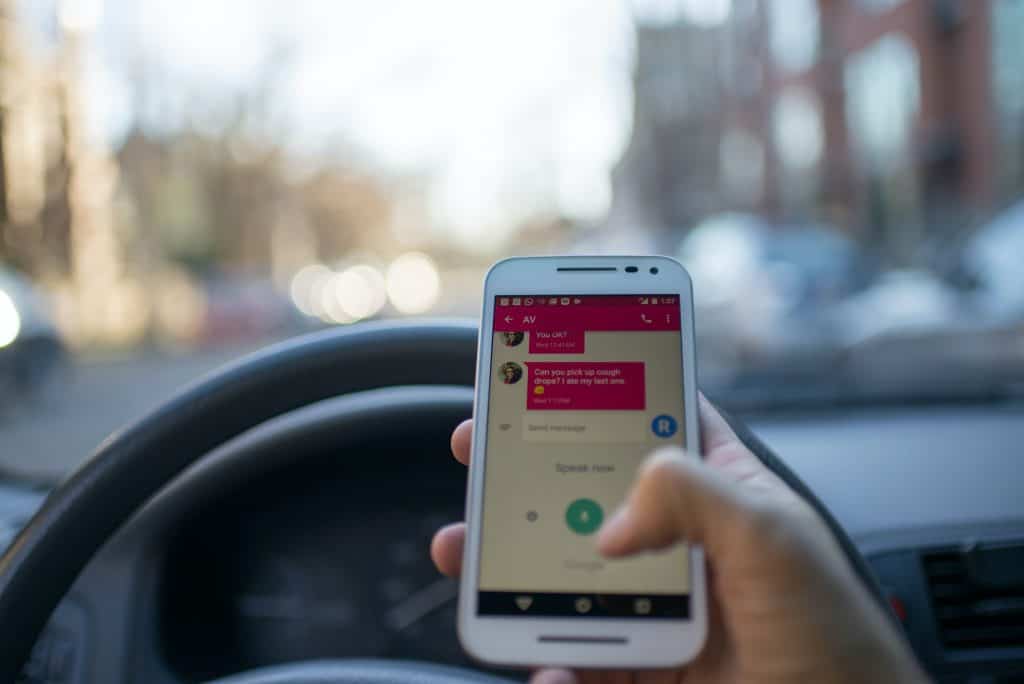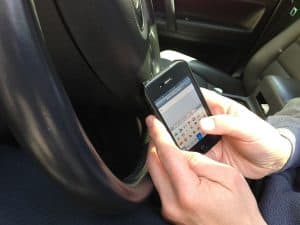
Texting while driving involves engaging in text messaging on a mobile device while operating a vehicle. Few issues have garnered as much attention as the risks associated with texting while driving because it has been shown to significantly increase the risk of traffic accidents.
According to the National Highway Traffic Safety Administration, texting while driving is six times more dangerous than driving while intoxicated, with the act of sending or reading a text taking the driver’s eyes off the road for an average of 4.6 seconds — enough time to cover the length of a football field at 55 mph, blindfolded (NHTSA, 2020).
Despite these stark statistics and the introduction of stringent laws in many jurisdictions aimed at curbing this dangerous practice, there is a persistent gap between awareness and behavior change among drivers, particularly adolescents and young adults.
Identities
- Glossary: Texting While Driving
- Wikipedia: Texting While Driving
- Wiktionary: n/a
- DBPedia: Texting While Driving
- ProductOntology: Texting While Driving
- Wikidata: Q11263493
- KnowledgePanel: /m/06zjw1b
Key Takeaways
- Texting while driving is extremely dangerous and increases the risk of being involved in a motor vehicle accident.
- The prevalence of texting while driving is higher among younger drivers.
- Research studies have shown that texting while driving negatively affects various safety-critical driving measures.
- Despite awareness of the dangers, a significant percentage of drivers, particularly young drivers, admit to texting while driving.
Defining Texting While Driving

Texting while driving, defined as the act of composing, sending, or reading text messages on a mobile device during vehicle operation, poses a significant hazard on the road. This behavior falls under the broader category of distracted driving, which the National Highway Traffic Safety Administration (NHTSA) regards as any activity that diverts attention from the task of safe driving.
Texting is particularly perilous because it involves cognitive, visual, and manual distractions. Research indicates that the average time a driver’s eyes are off the road while texting is approximately five seconds, enough to cover the length of a football field at 55 mph, essentially driving blindfolded (NHTSA).
The consensus among safety experts is clear: texting while driving substantially increases the likelihood of traffic incidents, with ramifications that can be severe and far-reaching.
Legal Restrictions and Bans
Recognizing the hazards associated with texting while driving, numerous governments around the world have implemented legal restrictions and bans to curb this dangerous practice.
In the United States, for instance, 48 states, the District of Columbia, Puerto Rico, Guam, and the U.S. Virgin Islands prohibit drivers from text messaging. This legislation typically encompasses writing, sending, or reading text messages and emails.
The enforcement of these laws varies, with some jurisdictions applying primary enforcement, allowing officers to cite drivers solely for texting offenses, while others require an additional traffic violation.
Penalties for violating texting while driving laws can include fines, points on a driver’s license, and even license suspension for repeat offenders.
These legal measures serve to deter the behavior and underscore the serious nature of distracted driving.
Dangers of Distracted Driving

Amid the array of activities that draw a driver’s attention away from the road, texting while driving is one of the most hazardous forms of distracted driving, significantly increasing the likelihood of traffic collisions. The risks associated with this behavior are multifaceted and well-documented:
- Cognitive Distraction: Texting diverts a driver’s mental focus from the driving task, leading to delayed recognition of traffic signals and road hazards.
- Visual Impairment: Eyes off the road, even for a few seconds, can mean missing critical visual cues necessary to navigate safely and respond to changing traffic conditions.
- Manual Interference: The act of texting requires drivers to remove their hands from the steering wheel, compromising vehicle control and maneuverability.
These factors combined contribute to a dramatic increase in the risk of accidents and injuries.
Age-Related Texting Statistics
While the dangers of distracted driving are clear, examining the data reveals that age plays a significant role in the prevalence of texting while driving, with certain age groups demonstrating a higher propensity for this risky behavior.
Statistics show that drivers between the ages of 20 to 29 are the most likely to engage in texting while behind the wheel. This age group’s heavy reliance on mobile technology for communication may contribute to the increased incidence of distracted driving.
Additionally, younger drivers, including teenagers, have admitted to texting while driving at notable rates, despite widespread awareness campaigns highlighting the risks.
These age-related statistics underscore the need for targeted educational efforts and enforcement strategies to address and mitigate the dangers of texting among specific, high-risk populations.
Scientific Findings on Safety

Scientific studies provide compelling evidence that texting while driving compromises road safety by significantly reducing the driver’s reaction time and attention to traffic signals and events. Research published in peer-reviewed journals outlines the quantifiable impact of this behavior on driving performance.
A study by the Virginia Tech Transportation Institute found that text messaging increases the risk of a crash or near-crash event by up to 23 times for heavy vehicle/light truck drivers.
The National Highway Traffic Safety Administration (NHTSA) reports that reading a text takes the driver’s eyes off the road for an average of 5 seconds, enough time to cover the length of a football field at 55 mph.
Research in the journal Traffic Injury Prevention concluded that texting impairs driving ability similar to a blood alcohol concentration of 0.08%, the legal limit in many jurisdictions.
Public Opinion on Texting Risks
How does the general public perceive the dangers of texting while driving, and what is the extent of their awareness regarding its risks? Public opinion surveys often reveal a widespread recognition of the hazards associated with texting behind the wheel. Individuals acknowledge that this behavior can lead to reduced reaction times, increased accident risk, and severe legal consequences. However, there remains a discrepancy between this awareness and the actual practices of drivers, especially among younger demographics.
| Aspect | Public Opinion | Notes |
|---|---|---|
| Risk Acknowledgment | High | Majority understand the dangers |
| Legal Consequences | Aware | Recognition of laws against texting while driving |
| Behavioral Change | Mixed | Some change habits, others do not |
| Age Factor | Younger drivers at risk | Higher incidence of texting while driving |
| Safety Priority | Agreed | General consensus on prioritizing safety over connectivity |
These findings suggest that while people are informed about the risks, translating that knowledge into consistent safe driving behavior is an ongoing challenge.
Young Drivers and Texting
The prevalence of texting while driving is particularly high among young drivers, who are more likely to underestimate the risks associated with this form of distracted driving.
Statistically, young drivers are more involved in texting-related vehicular incidents. For instance, the National Highway Traffic Safety Administration (NHTSA) reports that drivers under the age of 24 have a higher propensity for being distracted by phone use while driving.
Developmentally, younger drivers may lack the experience and judgement that older drivers possess. The Centers for Disease Control and Prevention (CDC) suggests that the combination of inexperience and a greater likelihood of risk-taking may contribute to higher accident rates among this demographic.
Educational interventions aimed at young drivers, such as awareness campaigns and driving courses that highlight the dangers of texting and driving, are crucial. Studies indicate that targeted education can reduce the incidence of texting while driving in younger age groups.
Texting Vs. Drunk Driving
Although often perceived as less severe than drunk driving, texting while driving can be equally or even more hazardous to road safety. Studies indicate that the reaction times of texting drivers can be significantly impaired, sometimes more so than those of drivers under the influence of alcohol.
Here is a comparative table highlighting key aspects of both behaviors:
| Aspect | Texting While Driving | Drunk Driving |
|---|---|---|
| Legal Status | Banned in many regions | Illegal everywhere |
| Risk of Accident | Up to 6 times more likely | High risk |
| Reaction Time Impairment | Comparable or greater | Less than texting |
| Public Perception | Increasingly viewed as risky | Universally recognized risk |
The table underscores that both behaviors are dangerous and have serious implications for road safety. It is crucial for drivers to understand the risks associated with each and to drive responsibly.
Accident Statistics Involvement
Annually, thousands of traffic accidents are attributable to texting while driving, highlighting the severe impact of this behavior on road safety. The statistics paint a sobering picture of the consequences that result when drivers divide their attention between the road and mobile devices.
- The National Safety Council reports that cell phone use while driving leads to 1.6 million crashes each year in the United States.
- According to the National Highway Traffic Safety Administration (NHTSA), in 2019, distracted driving was reported in crashes that killed 3,142 people—an increase of 10% from 2018.
- Research from the AAA Foundation for Traffic Safety indicates that reading a text message while driving can take your eyes off the road for an average of 5 seconds, enough time to cover the length of a football field at 55 mph, significantly increasing the likelihood of an accident.
Reaction Times and Texting
Texting while driving significantly impairs reaction times. Studies have shown that this behavior can delay a driver’s responses as much as or more than alcohol intoxication. For example, a study conducted by the Transport Research Laboratory reported that reaction times deteriorated by up to 35% when drivers were texting. In comparison, alcohol at the legal limit only caused a decline of 12%.
Furthermore, the Virginia Tech Transportation Institute found that text messaging creates a crash risk 23 times worse than driving while not distracted. This alarming statistic highlights the danger posed by texting while driving.
Perhaps most concerning is the fact that the act of reading or composing a text can distract a driver for approximately five seconds. To put this into perspective, five seconds is enough time to cover the length of a football field at typical highway speeds. This vast increase in the likelihood of an accident emphasizes the need for drivers to refrain from texting while behind the wheel.
Mid-Columbia Insurance – Your Trusted Insurance Agent
Call our independent insurance agent professionals today at (509)783-5600 or click “Get a Quote” to request an insurance quote today. Get the coverage you want at a price you can afford!
« Back to Glossary Index